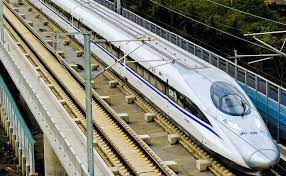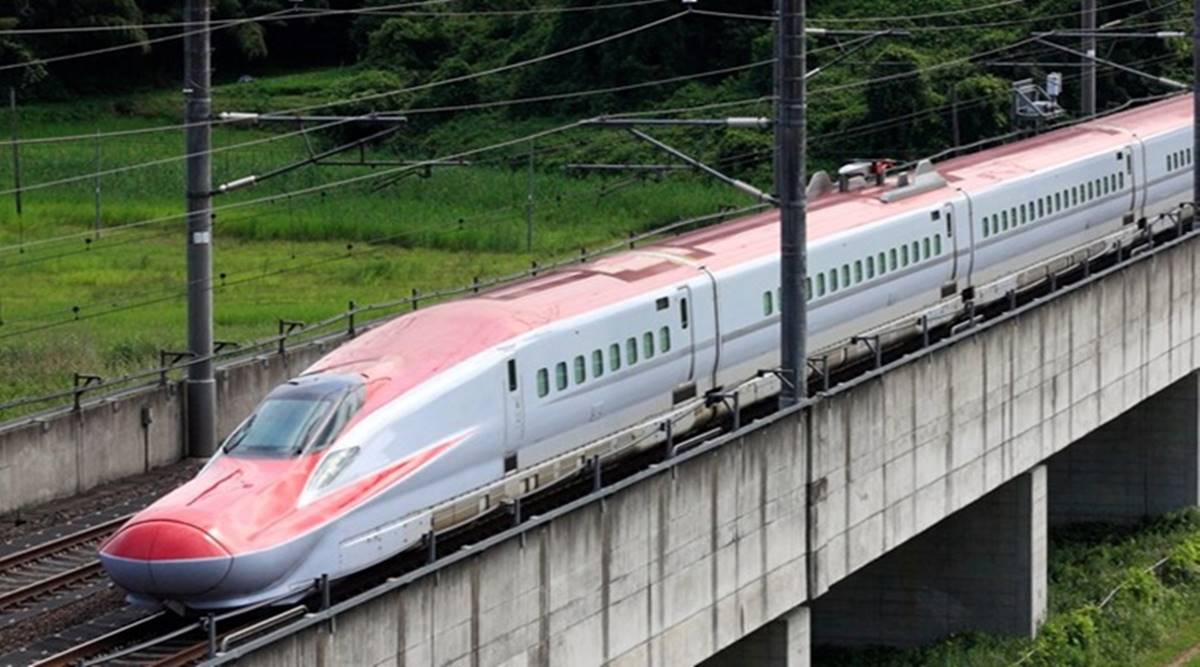Bullet train
Courtesy : www.zawya.com/
Indian Railways, the fourth-longest train network in the world, is poised to take a giant leap forward as a part of the country’s first bullet train is expected to become operational in about four years.
The Mumbai-Ahmedabad High-Speed Rail Corridor project, which will link two of the largest cities in western India, is now on track after initial hiccups and Covid-induced disruptions. The foundation stone for the high-speed line was laid in September 2017 by Indian Prime Minister Narendra Modi during a visit by his Japanese counterpart, Shinzo Abe, to the western state of Gujarat.
WHERE DO THINGS STAND?
As of late May, Gujarat had acquired 99 per cent of the land, Dadra & Nagar Haveli 100 per cent and Maharashtra 72 per cent. According to National High-Speed Rail Corporation Ltd authorities, the overall work is now progressing as per schedule so that trials can be conducted between Gujarat’s Bilimora and Surat in 2026 or by 2027.
Spanning 508.17km with a maximum operational speed of 320km per hour, the Mumbai-Ahmedabad bullet train corridor will have eight stations in Gujarat and four in Maharashtra. Surat, Sabarmati and Thane will be depots. The stations are: Surat, Vadodara, Anand, Ahmedabad, Sabarmati, Bilimora, Bharuch, Mumbai, Thane, Virar, Boisar, Vapi.
The MAHSR corridor would traverse through Gujarat (in 8 districts), Dadra & Nagar Haveli, and Maharashtra (in 3 districts). The funding, estimated at $17 billion, is provided by the Japan International Corporation Agency (JICA). The project escalation, as per practice, was accommodated during the joint feasibility study. Exigent impacts, if any, will be discussed with the funding agency. In overall capital structure, 81 per cent will be funded by the government of Japan and the rest by the government of India. In Gujarat and Dadra & Nagar Haveli, 100 per cent of civil and track contracts for the construction of the route, i.e. 352km, have been awarded to Indian contractors.
The work on piles, foundations, piers, pier caps, casting and erection of girders for viaducts and stations has started on various stretches all along the 352km alignment passing through eight districts of Gujarat. Bridge works on all rivers in Gujarat have begun and are expected to be completed by 2024.
The state-of-the-art high-speed train will run on the Japanese Shinkansen technology, which offers one of the highest levels of safety standards. As per the agreement between India and Japan, the project has ‘Make in India’ and ‘Transfer of Technology’ components embedded in it.
The entire journey will be covered in 2.07 hours with limited stops at Surat, Vadodara and Ahmedabad. The all stop train will take 2 hours 57 minutes. While the majority of the line will be built overground (463km on viaducts), there will also be a mixed bag of tunnels (26km), bridges (9km) and embankments (13km) spanning the entire journey. Among these will be a 21km-long tunnel near Mumbai, of which 1.8km will run under the seabed, a first for India.
As per current estimates, the corridor is expected to be used by 17,900 passengers every day in each direction. They will be ferried in 35 daily train trips made by 10-car configurations with 24 rakes in the year of commissioning. Train services will operate from 6am to midnight at intervals of 30 minutes. The bullet train will have three classes defined by the configuration of seats — standard class (3×2 seats), business class (2×2 seats) and grand class (2×1 seats). A dedicated HighSpeed Rail Training Institute being set up in Vadodara will serve as a benchmark for the future development of other high-speed corridors in India.
Railway Minister Ashwini Vaishnaw said last week they are confident of achieving the target of running the country’s first bullet train between Surat and Bilimora in Gujarat in 2026 as good progress has been made in this direction. The National Rail Plan-India envisions enhancing the outreach of the highspeed rail system and increasing connectivity to all cities of importance. Seven new corridors have been identified: Delhi-Lucknow-Varanasi (865km), Varanasi-Patna-Howrah (760km), Delhi-JaipurUdaipur-Ahmedabad (886km), Delhi-ChandigarhLudhiana-Jalandhar-Amritsar (459km), MumbaiNashik-Nagpur (753km), Mumbai-Pune-Hyderabad (711km) and Chennai-Bengaluru-Mysore (435km).
With a network of 70,000km, Indian Railways ferries 8,300 million passengers and 11,160 million tonnes of freight every year.




